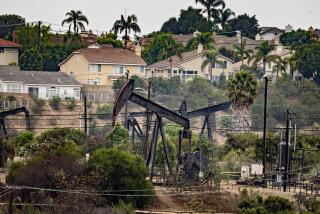No Hurry for Tapping Offshore Oil
San Diego has had a marriage of convenience for years with the Navy in the fight against offshore oil drilling. San Diegans want to avoid the air pollution, potential spills and the unsightliness of drilling platforms along their coast. The Navy wants to keep the waters clear for training operations. When environmental and aesthetic arguments failed to dissuade proponents of drilling, San Diego could always fall back on the need to protect military interests.
Recently, however, the military’s opposition to offshore drilling has softened. The Navy has agreed that eight tracts off Carlsbad and Oceanside could be leased for oil drilling without harming Navy and Marine Corps interests.
These tracts, as close as 3 miles from shore, had been off limits, but were recently added to a Department of Interior’s list of tracts for possible lease sale in 1990. The list includes other tracts off San Diego County; but the next closest is more than 12 miles offshore.
Some local officials think the Navy has let San Diego down. In truth, the Navy has done nothing more than protect its own interests. The result of the Navy’s new stance is that San Diego County will have to rely more on environmental and economic arguments in the upcoming debate.
But those are strong arguments, as the environmental review of a similar lease sale proposal in 1983 revealed. And they raise serious questions that the new secretary of the Interior will have to answer about the wisdom of drilling off San Diego County.
First and foremost, does it make sense to open virgin territory to drilling when preliminary estimates indicate that there are very limited amounts of recoverable oil off San Diego County? Based on figures in the 1983 review, the “most likely” estimate of recoverable oil off San Diego County is about 20 million barrels, or a little more than the nation uses in one day.
Given those resource estimates, does it make sense to risk oil spills in an area known nationwide for its beaches, an area where tourism is one of the most important industries?
Given those resource estimates, does it make sense to allow drilling operations that would contribute to air pollution in an area that already fails to meet federal air quality standards?
Air pollution, resource estimates and the likelihood of spills are just a few of the issues that will be addressed during the environmental impact studies and the review process that will be conducted by the Department of the Interior over the next year before a decision is made on what tracts to lease.
Weighing in on the other side will be national interests: the United States wants to reduce its dependence on foreign oil, which accounts for about 60% of the oil consumed in the United States. Also, the oil leases are an important source of revenue for the deficit-laden federal government.
Reducing dependence on foreign oil is certainly an important national goal. But conservation might be a better approach than risking damage to a beautiful stretch of beach for what could be about a day’s worth of oil.
The oil industry discounts the marginal-supply argument by saying that most of the U. S. oil supply is from small finds, and, if limited reserves were a good reason to prevent drilling, there would be very little U. S. oil production. That argument sounds good when looking at the total oil supply picture, but it does not negate the need to weigh the benefits of each drilling decision against the potential gain.
The time may come when drilling off San Diego County is necessary, but we question whether that time is now. Delaying the drilling could buy time for technological advances that could reduce the air pollution associated with drilling and could further protect against spill damage.
The oil is not lost by delaying, and the country gains by preserving its coastline a while longer.
More to Read
Sign up for Essential California
The most important California stories and recommendations in your inbox every morning.
You may occasionally receive promotional content from the Los Angeles Times.










